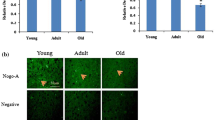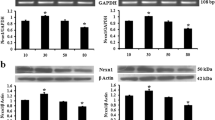Abstract
S100β is a soluble calcium binding protein released by glial cells. It has been reported as a neurotrophic factor that promotes neurite maturation and outgrowth during development. This protein also plays a role in axonal stability and in long term potentiation in the adult brain. The ability of S100β to modulate neuronal morphology raises the important question whether there is an age-related difference in the expression of S100β in the cerebral and cerebellar cortices of AKR strain mice and is this change is region specific. Our RT–PCR and Western blotting experiments show that the expression of S100β gene in the cerebral and cerebellar cortices starts from 0 day, peaks at about 45 days. However, in 70-week old mice its expression is significantly up-regulated as compared to that of 20-week old mice. S100β follows the same age-related pattern in both cerebral and cerebellar cortices. These results suggest that S100β is important for brain development and establishment of proper brain functions. Up-regulation of S100β in old age may have some role in development of age-related pathological systems in the brain.



Similar content being viewed by others
References
Barger SW, Wolchok SR, Van Eldik LJ (1992) Disulfide-linked S100 beta dimers and signal transduction. Biochim Biophys Acta 1160:105–112
Barger SW, Van Eldik LJ, Mattson MP (1995) S100 beta protects hippocampal neurons from damage induced by glucose deprivation. Brain Res 677:167–170
Baudier J, Cole RD (1988) Reinvestigation of the sulfhydryl reactivity in bovine brain S100b (beta beta) protein and the microtubule-associated tau proteins. Ca2+ stimulates disulfide cross-linking between the S100b beta-subunit and the microtubule-associated tau (2) protein. Biochemistry 27:2728–2736
Beaudeux J, Dequen L, Foglietti M (1999) Pathophysiologic aspects of S-100beta protein: a new biological marker of brain pathology. Ann Biol Clin 57:261–272
Bhattacharyya A, Oppenheim RW, Prevette D, Moore BW, Brackenbury R, Ratner N (1992) S100 is present in developing chicken neurons and Schwann cells and promotes motor neuron survival in vivo. J Neurobiol 23:451–466
Bianchi R, Garbuglia M, Verzini M, Giambanco I, Ivanenkov VV, Dimlich RV, Jamieson GA, Donato R Jr (1996) S-100 (alpha and beta) binding peptide (TRTK-12) blocks S-100/GFAP interaction: identification of a putative S-100 target epitope within the head domain of GFAP. Biochim Biophys Acta 1313:258–267
Bradford MM (1976) A rapid and sensitive method for the quantitation of microgram quantities of protein utilizing the principle of protein-dye binding. Anal Biochem 72:248–254
Donato R (1999) Functional roles of S100 proteins, calcium-binding proteins of the EF-hand type. Biochim Biophys Acta 1450:191–231
Donato R (2001) S100: a multigenic family of calcium-modulated proteins of the EF-hand type with intracellular and extracellular functional roles. Int J Biochem Cell Biol 33:637–668
Donato R, Isobe T, Okuyama T (1985) S-100 proteins and microtubules: analysis of the effects of rat brain S-100 (S-100b) and ox brain S-100a0, S-100a and S-100b on microtubule assembly-disassembly. FEBS. Lett 186:65–69
Fanò G, Fulle S, Della Torre G, Giambanco I, Aisa MC, Donato R, Calissano P (1988) S-100b protein regulates the activity of skeletal muscle adenylate cyclase in vitro. FEBS Lett 240:177–180
Fulle S, Pietrangelo T, Mariggio MA, Lorenzon P, Racanicchi L, Mozrzymas J, Guarnieri S, Zucconi-Grassi G, Fano G (2000) Calcium and fos involvement in brain-derived Ca(2+)-binding protein (S100)-dependent apoptosis in rat phaeochromocytoma cells. Exp Physiol 85:243–253
Garbuglia M, Verzini M, Giambanco I, Spreca A, Donato R (1996) Effects of calcium-binding proteins (S-100a (o), S-100a, S-100b) on desmin assembly in vitro. FASEB J 10:317–324
Gonçalves DS, Lenz G, Karl J, Gonçalves CA, Rodnight R (2000) Extracellular S100B protein modulates ERK in astrocyte cultures. Neuroreport 11:807–809
Griffin WS, Stanley LS, Ling C, White L, MacLeod V, Perrot LJ, White CL, Araoz C (1989) Brain interleukin 1 and S100 immunoreactivity are elevated in Down syndrome and Alzheimer disease. Proc Natl Acad Sci USA 86:7611–7615
Griffin WS, Yeralan O, Sheng JG, Boop FA, Mrak RE, Rovnaghi CR, Burnett BA, Feoktistova A, Van Eldik LJ (1995) Overexpression of the neurotrophic cytokine S100 beta in human temporal lobe epilepsy. J Neurochem 65:228–233
Haglid KG, Yang Q, Hamberger A, Bergman S, Widerberg A, Danielsen N (1997) S-100beta stimulates neurite outgrowth in the rat sciatic nerve grafted with acellular muscle transplants. Brain Res 753:196–201
Hayakawa N, Kato H, Araki T (2007) Age-related changes of astorocytes, oligodendrocytes and microglia in the mouse hippocampal CA1 sector. Mech Ageing Dev 128:311–316
Heizmann CW, Fritz G, Schäfer BW (2002) S100 proteins: structure, functions and pathology. Front Biosci 7:d1356–d1368
Henderson G, Tomlinson BE, Gibson PH (1980) Cell counts in human cerebral cortex in normal adults throughout life using an image analyzing computer. J Neurol Sci 46:113–136
Hu J, Ferreira A, Van Eldik LJ (1997) S100beta induces neuronal cell death through nitric oxide release from astrocytes. J Neurochem 69:2294–2301
Huttunen HJ, Kuja-Panula J, Sorci G, Agneletti AL, Donato R, Rauvala H (2000) Coregulation of neurite outgrowth and cell survival by amphoterin and S100 proteins through receptor for advanced glycation end products (RAGE) activation. J Biol Chem 275:40096–40105
Iwasaki Y, Shiojima T, Kinoshita M (1997) S100 beta prevents the death of motor neurons in newborn rats after sciatic nerve section. J Neurol Sci 151:7–12
Kato K, Suzuki F, Morishita R, Asano T, Sato T (1990) Selective increase in S-100 beta protein by aging in rat cerebral cortex. J Neurochem 54:1269–1274
Kligman D, Marshak DR (1985) Purification and characterization of a neurite extension factor from bovine brain. Proc Natl Acad Sci USA 82:7136–7139
Landar A, Caddell G, Chessher J, Zimmer DB (1996) Identification of an S100A1/S100B target protein: phosphoglucomutase. Cell Calcium 20:279–285
Leviton A, Dammann O (2002) Brain damage markers in children. Neurobiological and clinical aspects. Acta Paediatr 91:9–13
Linnemann D, Skarsfelt T (1994) Regional changes in expression of NCAM, GFAP, and S100 in aging rat brain. Neurobiol Aging 15:651–655
Margulis A, Pozdnyakov N, Sitaramayya A (1996) Activation of bovine photoreceptor guanylate cyclase by S100 proteins. Biochem Biophys Res Commun 218:243–247
Marshak DR (1990) S100 beta as a neurotrophic factor. Prog Brain Res 86:169–181
Marshak DR, Pesce SA, Stanley LC, Griffin WS (1992) Increased S100 beta neurotrophic activity in Alzheimer’s disease temporal lobe. Neurobiol Aging 13:1–7
Millward TA, Heizmann CW, Schäfer BW, Hemmings BA (1998) Calcium regulation of Ndr protein kinase mediated by S100 calcium-binding proteins. EMBO J 17:5913–5922
Moore BW (1965) A soluble protein characteristic of the nervous system. Biochem Biophys Res Commun 19:739–744
Motin VG, Nikitin VP, Sherstnev VV (2002) Effects of antibodies against protein S100b on synaptic transmission and long-term potentiation in CA-1 hippocampal neurons in rats. Bull Exp Biol Med 133:110–113
Mrak RE, Sheng JG, Griffin WS (1995) Glial cytokines in Alzheimer’s disease: review and pathogenic implications. Hum Pathol 26:816–823
Nishiyama H, Knopfel T, Endo S, Itohara S (2002) Glial protein S100B modulates long-term neuronal synaptic plasticity. Proc Natl Acad Sci USA 99:4037–4042
Patel J, Marangos PJ, Heydorn WE, Chang G, Verma A, Jacobowitz D (1983) S-100-mediated inhibition of brain protein phosphorylation. J Neurochem 41:1040–1045
Peskind ER, Griffin WS, Akama KT, Raskind MA, Van Eldik LJ (2001) Cerebrospinal fluid S100B is elevated in the earlier stages of Alzheimer’s disease. Neurochem Int 39:409–413
Pozdnyakov N, Margulis A, Sitaramayya A (1998) Identification of effector binding sites on S100 beta: studies with guanylate cyclase and p80, a retinal phosphoprotein. Biochemistry 37:10701–10708
Reeves RH, Yao J, Crowley MR, Buck S, Zhang X, Yarowsky P, Gearhart JD, Hilt DC (1994) Astrocytosis and axonal proliferation in the hippocampus of S100b transgenic mice. Proc Natl Acad Sci USA 91:5359–5363
Scheibel ME, Scheibel AB (1975) Structural changes in the aging brain. In: Brody H, Herman D, Ordy JM (eds) Aging, vol 1. Raven Press, New York, pp 11–37
Selinfreund RH, Barger SW, Pledger WJ, Van Eldik LJ (1991) Neurotrophic protein S100 beta stimulates glial cell proliferation. Proc Natl Acad Sci USA 88:3554–3558
Shanti K, Kanungo MS (2004) Expression of muscle creatine kinase gene of mice and interaction of nuclear proteins with MEF-2, E boxes and A/T-rich elements during aging. Mol Biol Rep 31(1):43–50
Sheng JG, Mrak RE, Griffin WS (1994) S100 beta protein expression in Alzheimer disease: potential role in the pathogenesis of neuritic plaques. J Neurosci Res 39:398–404
Sheng JG, Mrak RE, Rovnaghi CR, Kozlowska E, Van Eldik LJ, Griffin WS (1996) Human brain S100 beta and S100 beta mRNA expression increases with age: pathogenic implications for Alzheimer’s disease. Neurobiol Aging 17:359–363
Singh K, Prasad S (2008) Differential expression of Fmr-1 mRNA and FMRP in female mice brain during aging. Mol Biol Rep 35(4):677–684
Sorci G, Agneletti AL, Bianchi R, Donato R (1998) Association of S100B with intermediate filaments and microtubules in glial cells. Biochim Biophys Acta 1448:277–289
Tramontina F, Conte S, Gonçalves D, Gottfried C, Portela LV, Vinade L, Salbego C, Gonçalves CA (2002) Developmental changes in S100B content in brain tissue, cerebrospinal fluid, and astrocyte cultures of rats. Cell Mol Neurobiol 22:373–378
Ueda S, Kokotos Leonardi ET, Bell J III, Azmitia EC (1995) Serotonergic sprouting into transplanted C-6 gliomas is blocked by S-100 beta antisense gene. Brain Res Mol Brain Res 29:365–368
Van Eldik LJ, Wainwright MS (2003) The Janus face of glial-derived S100B: beneficial and detrimental functions in the brain. Restor Neurol Neurosci 21:97–108
Van Eldik LJ, Christie-Pope B, Bolin LM, Shooter EM, Whetsell WO Jr (1991) Neurotrophic activity of S-100 beta in cultures of dorsal root ganglia from embryonic chick and fetal rat. Brain Res 542:280–285
Winningham-Major F, Staecker JL, Barger SW, Coats S, Van Eldik LJ (1989) Neurite extension and neuronal survival activities of recombinant S100 beta proteins that differ in the content and position of cysteine residues. J Cell Biol 109:3063–3071
Xiong Z, O’Hanlon D, Becker LE, Roder J, MacDonald JF, Marks A (2000) Enhanced calcium transients in glial cells in neonatal cerebellar cultures derived from S100B null mice. Exp Cell Res 257:281–289
Zimmer DB, Van Eldik LJ (1986) Identification of a molecular target for the calcium-modulated protein S100. Fructose-1,6-bisphosphate aldolase. J Biol Chem 261:11424–11428
Zimmer DB, Van Eldik LJ (1989) Analysis of the calcium-modulated proteins, S100 and calmodulin, and their target proteins during C6 glioma cell differentiation. J Cell Biol 108:141–151
Acknowledgments
This research was supported by a grant from the Department of Science and Technology (DST), Govt. of India (SP/SO/B01/2001), to M.S.K. Prashant Kumar Modi thanks the DST for a Junior Research Fellowship and Indian Council of Medical Research, Govt. of India, New Delhi, for a Senior Research fellowship (45/24/2007/Basic research in aging/BMS).
Author information
Authors and Affiliations
Corresponding author
Rights and permissions
About this article
Cite this article
Modi, P.K., Kanungo, M.S. Age-dependent Expression of S100β in the Brain of Mice. Cell Mol Neurobiol 30, 709–716 (2010). https://doi.org/10.1007/s10571-009-9495-y
Received:
Accepted:
Published:
Issue Date:
DOI: https://doi.org/10.1007/s10571-009-9495-y




